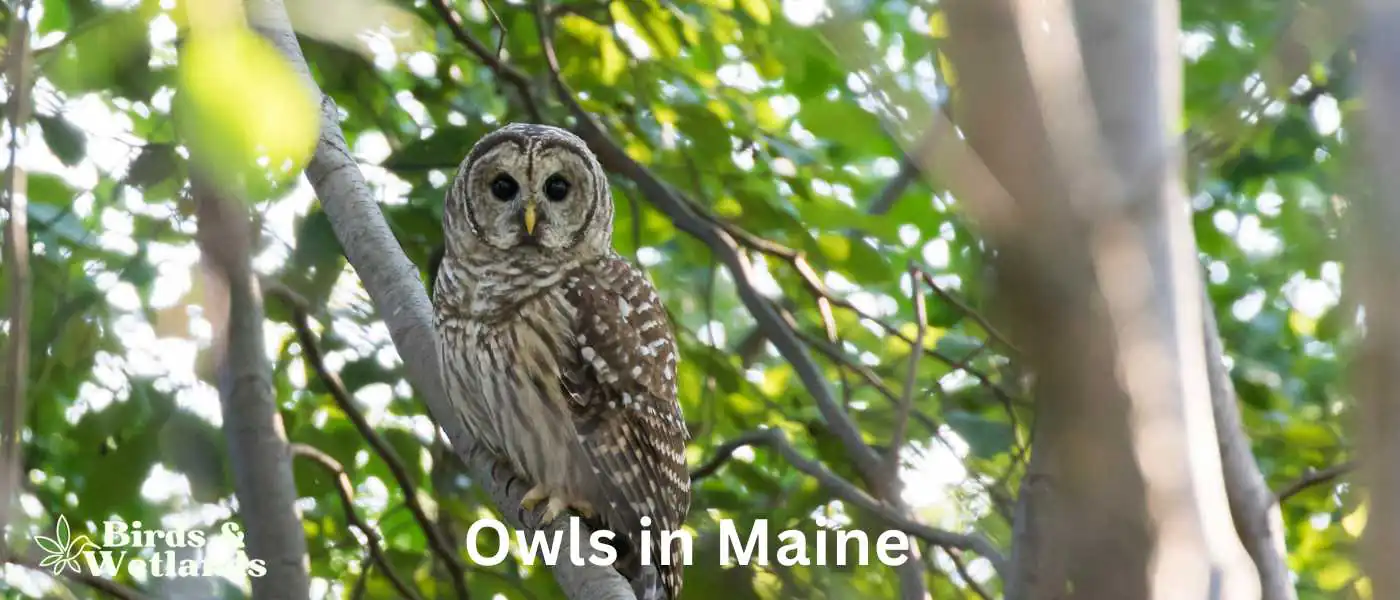Within the diverse habitats of Maine, from its deep forests to its rocky coastlines and sprawling wetlands, a captivating array of owls can be found. These nocturnal Maine Preying Birds play an integral role in Maine’s ecosystems, serving as both formidable predators and important links in their respective food chains.
Maine Owls
| Owl Species | Frequency in Maine | Presence in Maine | Where to Find in Maine |
|---|---|---|---|
| Great Horned Owl | High | Statewide | Acadia National Park, Bar Harbor; Baxter State Park, Millinocket |
| Eastern Screech Owl | High | Statewide | Coastal Maine Botanical Gardens, Boothbay; Maine Wildlife Park, Gray |
| Barred Owl | High | Statewide | Allagash Wilderness Waterway, North Maine Woods; Mount Desert Island, Hancock County |
| Snowy Owl | Moderate (Seasonal) | Statewide in Winter | Portland International Jetport, Portland; Presque Isle, Aroostook County |
| Northern Saw-whet Owl | Moderate | Statewide | Camden Hills State Park, Camden; Sunkhaze Meadows National Wildlife Refuge, Milford |
| Long-eared Owl | Low | Scattered Across State | Rachel Carson National Wildlife Refuge, Wells; Petit Manan National Wildlife Refuge, Steuben |
| Short-eared Owl | Low | Open Fields and Grasslands | Kennebunk Plains, Kennebunk; Sunkhaze Meadows National Wildlife Refuge, Milford |
| Great Gray Owl | Very Low | Northern Maine | Aroostook National Wildlife Refuge, Limestone; Allagash Wilderness Waterway, North Maine Woods |
| Barn Owl | Uncommon | Found mainly in the southern part of the state | Towns of Kennebunkport and Wells |
| Boreal Owl | Rare | Seen in the northernmost part of the state, particularly in the colder months | Baxter State Park and the Allagash Wilderness Waterway |
Owl Species Found in Maine
Great Horned Owl (Bubo virginianus)
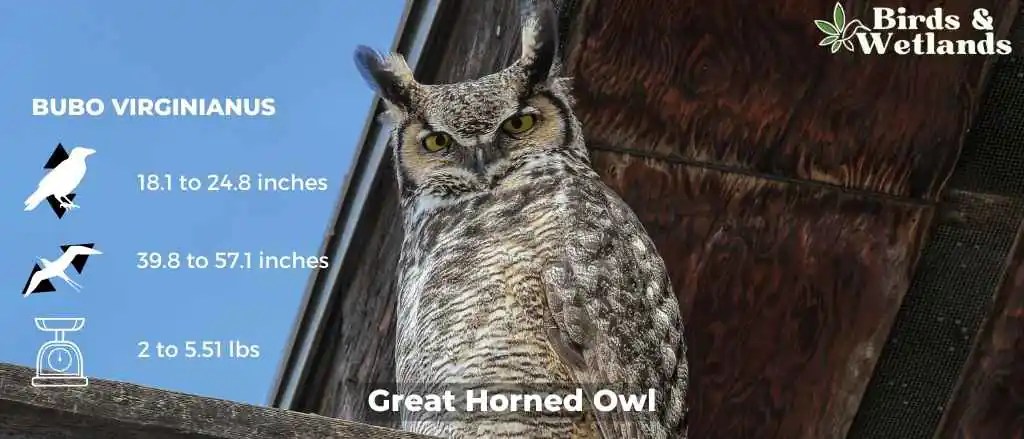

Great Horned Owl Sound
Scientific Name:Bubo virginianus
Length: 18.1-24.8 in
Wingspan: 39.8-57.1 in
Weight: 32.1-88.2 oz
The Great Horned Owl is a large owl with long wings and a large head. It’s one of the most common owls in North America.
Great Horned Owls are large, stocky birds with soft feathers that are gray to brown on their backs and white on their chests. Their faces are characterized by two black “ear” tufts, which can be raised or flattened depending on the owl’s mood. The eyes are yellow, orange, or red in color.
The habitat of the Great Horned Owl is a variety of different environments such as forests and deserts. They also live near water sources such as lakes, streams and rivers where they can hunt for fish.
The diet of the Great Horned Owl consists primarily of small mammals such as mice and rats; however they will also eat other rodents such as squirrels, rabbits and porcupines. They have been known to eat skunks too.
Eastern Screech-Owl (Megascops asio)
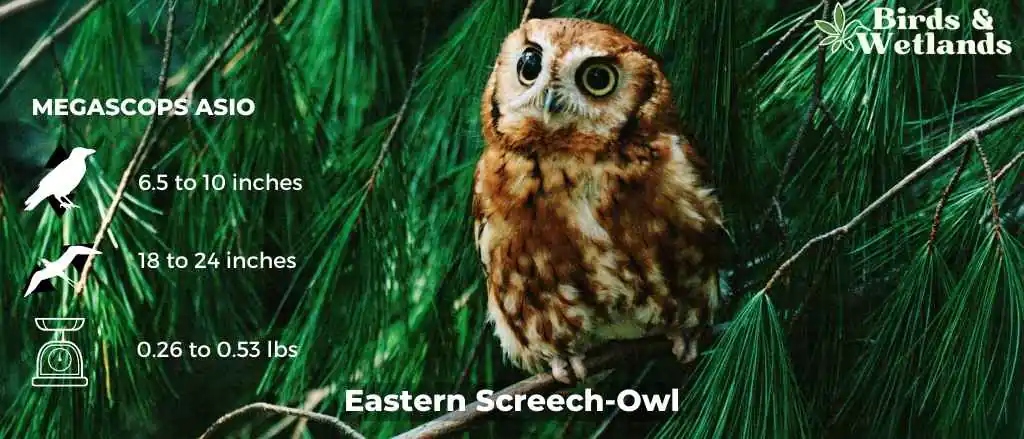
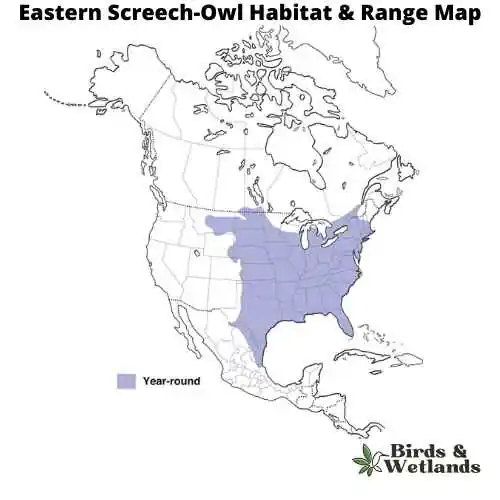
Eastern Screech-Owl Sound
Scientific Name: Megascops asio
Length: 6 to 10 in
Wingspan: 8 to 24 in
Weight: 4 – 8.5 oz
The Eastern Screech-Owl is a small owl species native to most wooded environments of the eastern half of North America, from the Canadian provinces to Florida and Texas.
Eastern Screech-Owls are relatively small and exhibit a complex pattern of gray or reddish-brown coloration, which provides excellent camouflage against tree bark.
These owls are known for their distinctive call, which is often described as a haunting trill or a whinny-like sound. Despite their name, they do not actually produce a “screech.”
Eastern Screech-Owls feed on a variety of prey, ranging from small mammals and birds to insects and even earthworms. It is primarily nocturnal, hunting at night from a low perch and swooping down onto prey.
Eastern Screech-Owls nest in tree cavities or abandoned woodpecker nests, but they readily adapt to nesting boxes where natural cavities are not available. They typically lay between 2 to 6 eggs, which are incubated primarily by the female.
Barred Owl (Strix varia)


Barred Owl Sound
Scientific Name: Strix varia
Length: 40 to 63 cm (16 to 25 in)
Wingspan: 96 to 125 cm (38 to 49 in)
Weight: 468 to 1,150 g
The Barred Owl is a medium-sized owl with a barred pattern on its chest and belly. They have large yellow eyes that allow them to see well in low light conditions. Their ears are not very large which means they do not hear very well but they have excellent hearing abilities which allow them to detect sounds up to 1 mile away. Their feathers are brown and streaked with white, and they have black bars on their chests and wings.
Their habitats include forests, woodlands, orchards, parks, farmland and suburban backyards.
Barred Owls (also known as hoot owl) eat small mammals such as mice, rats and squirrels. They also eat insects such as beetles or grasshoppers. These owls hunt during the day when it is light out so that they can see their prey better than at night when they would be using senses other than sight like sound or smell to find their food source.
Barred owls are monogamous birds which means they mate for life. They build nests in trees or cavities on the ground and lay 2-4 eggs per year. The incubation period for these eggs lasts about 28 days before hatching takes place.
Barn Owl (Tyto alba)

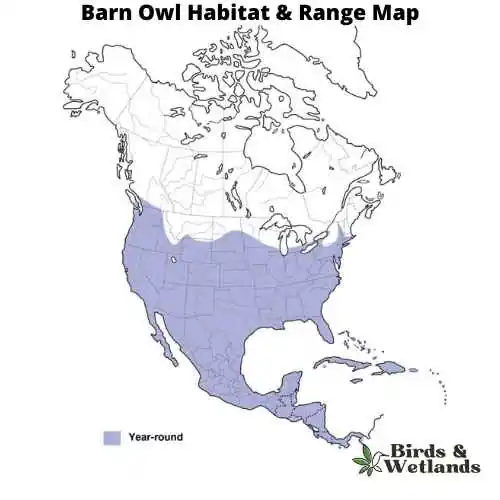
Barn Owl Sound
Scientific Name: Tyto alba
Length: 13 to 15 in
Wingspan: 31 to 37 in
Weight: 9.2 oz
The Barn Owl is a widespread species of owl known for its distinctive heart-shaped facial disc.
Barn Owls are medium-sized owls, they are pale overall with golden-brown wings and back, contrasted by a white face, chest, and belly. Their most notable feature is their heart-shaped facial disc, which helps channel sound to their ears.
Barn Owls are typically found in open habitats, including farmland, woodland, and marshes. They are named for their habit of nesting in human structures such as barns, church towers, and in the hollows of large trees. These owls are nocturnal, hunting at night and roosting during the day.
The diet of Barn Owls primarily consists of small mammals, particularly rodents such as mice and rats. They are known for their silent flight, which allows them to sneak up on their prey without detection.
Barn Owls have a unique nesting behavior. They do not build nests, but instead, lay their eggs directly on the bare surface of a secluded ledge or cavity. A female typically lays 4-7 eggs, and both parents help incubate the eggs and care for the chicks.
The long-eared owl (Asio otus)
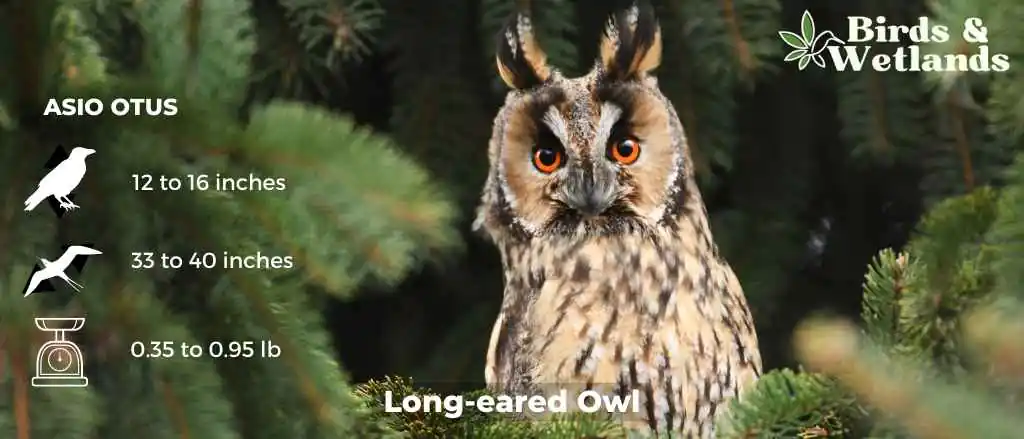

Long-eared Owl Sound
Scientific Name: Asio otus
Length: 12 and 16 in
Wingspan: 2 ft 10 in to 3 ft 4 in
Weight: 5.6 to 15.3 oz
The Long-eared Owl is a medium-sized owl species known for its distinctively long ear tufts, which can be raised or lowered depending on the bird’s mood or intention.
Long-eared Owls have mottled brown and cream plumage, which provides excellent camouflage among the trees. Their most distinctive features are their long, black-tipped ear tufts, which are set closer to the center of the head than in most other owl species.
These owls inhabit a wide variety of habitats, including deciduous and coniferous forests, woodlands, and even semi-deserts.
The Long-eared Owl’s diet primarily consists of small mammals, especially voles, but they will also take small birds and insects. They are skillful hunters, often capturing prey from a perch or in flight.
In terms of nesting behavior, Long-eared Owls do not construct their own nests, instead they take over old nests built by other bird species, usually those of corvids or other large birds. They lay an average of 4 to 5 eggs, which are incubated by the female while the male provides food.
Short-eared Owl (Asio flammeus)
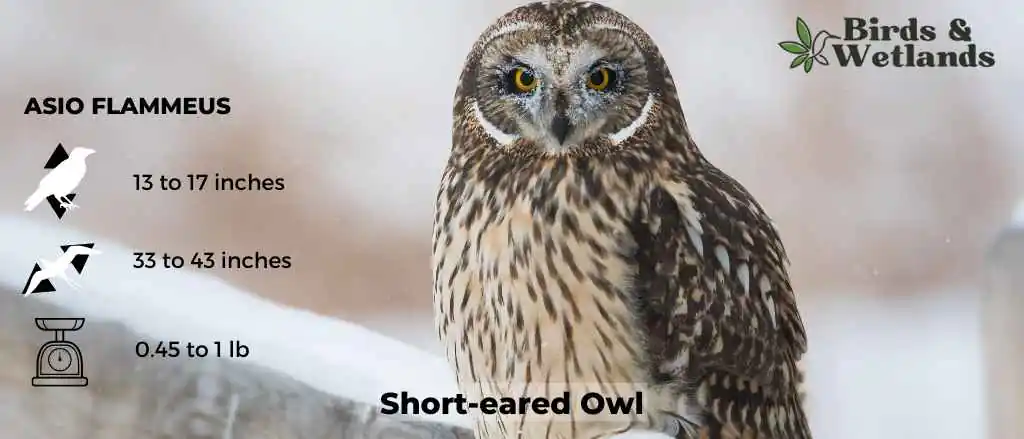
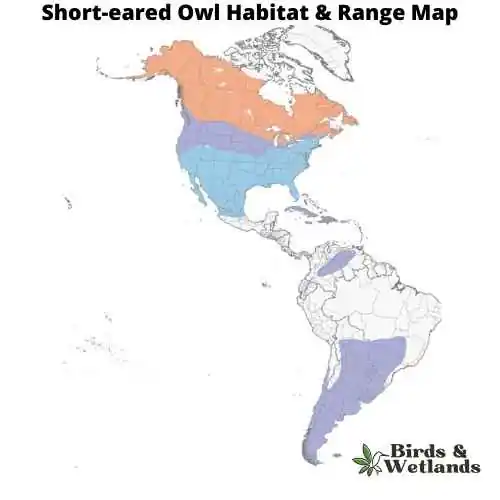
Short-eared Owl Sound
Scientific Name: Asio flammeus
Length: 13–17 in
Wingspan: 33 to 43 in
Weight: 7.3–16.8 oz
The Short-eared Owl is a medium-sized owl species with a wide distribution, found across North and South America, Europe, Asia, and many Pacific islands. Despite its name, the “ears” of the Short-eared Owl are not often visible, as they are small and tend to blend with the bird’s feathers.
The owls are predominantly brown with buff and white accents throughout their body and wings, and dark patches around their yellow eyes.
Short-eared Owls diet consists largely of small mammals, especially voles. However, they are opportunistic hunters and will also prey on a variety of other animals, including other birds, when available.
Their habitat is characterized by open areas like grasslands, marshes, and tundra. They nest on the ground, which is unusual for owls, and this makes them vulnerable to ground predators. As such, they often live in areas with tall grasses or other ground cover for protection.
Northern Saw-whet Owl (Aegolius acadicus)
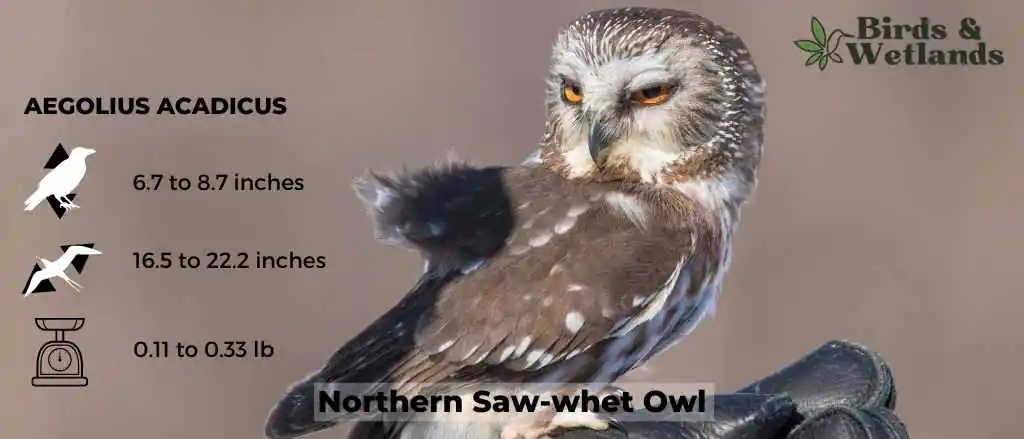

Northern Saw-whet Owl Sound
Scientific Name: Aegolius acadicus
Length: 17–22 cm (6.7–8.7 in)
Wingspan: 42–56.3 cm (16.5–22.2 in)
Weight: 54 to 151 g (1.9 to 5.3 oz)
The Northern Saw-whet Owl is a tiny, speckled gray owl and it’s one of the smallest owls in North America. It’s also known as the Little Owl or Wood Owl in some areas.
Northern Saw-whet Owls have dark brown eyes, white eyebrows, and yellow beak. It has brownish-grey feathers that are spotted with white. The owl’s legs are covered in feathers and appear nearly invisible when the bird is perched on a branch or tree.
In the winter they migrate south to warmer climates. They prefer to live in dense coniferous forest with large trees but will occasionally nest in shrubs or other vegetation that can protect them from predators.
The Northern Saw-whet Owl eats mice and voles (small rodents), small birds, frogs, salamanders, moles and shrews, but unlike most owls they chop their prey up and spread over a few meals. They will also eat insects like beetles and grasshoppers if they are available. It hunts from a perch at night using its excellent hearing to locate prey items within about 30 feet (9 meters) of its nest.
These owls nest in tree cavities usually located close to water sources such as lakes or rivers where they can find their food source (insects). They lay 2-4 eggs at one time which incubate for about 30 days before hatching.
Snowy owl (Bubo scandiacus)

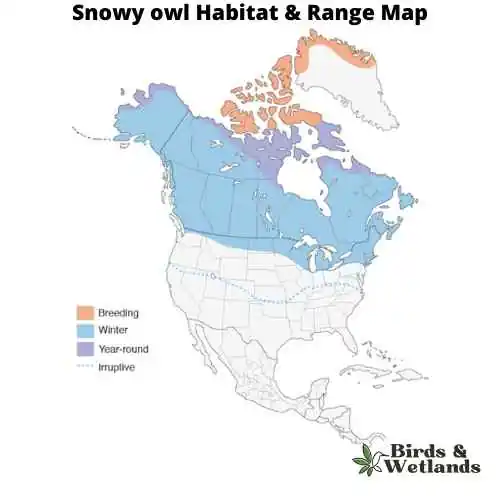
Snowy owl Sound
Scientific Name: Bubo scandiacus
Length: 20.7 to 28 in
Wingspan: 3 ft 10 in to 6 ft 0 in
Weight: 3.2lb to 5.3lb
The Snowy Owl, is of the most well-known species of owls, the Snowy Owl is renowned for its striking appearance and adaptations to its extreme environment.
Snowy Owls are medium sized birds that possess a rounded head, yellow eyes, and a black beak. The most distinctive feature of the Snowy Owl is its white plumage, which provides effective camouflage in its snowy habitat. Male Snowy Owls are often almost completely white, while females and younger owls have more extensive dark barring on their plumage.
Unlike many owl species, Snowy Owls are primarily diurnal, which means they are active during the day. This is an adaptation to life in the Arctic, where there can be 24 hours of daylight in the summer. Their diet mainly consists of small mammals, particularly lemmings, but they are known to eat a variety of animals including birds, fish, and even carrion when necessary.
Snowy Owls nest on the ground, usually on a mound or boulder. Their breeding success is closely tied to the availability of food, and in good years a single pair of owls can raise a large brood of chicks.
Boreal Owl (Aegolius funereus)
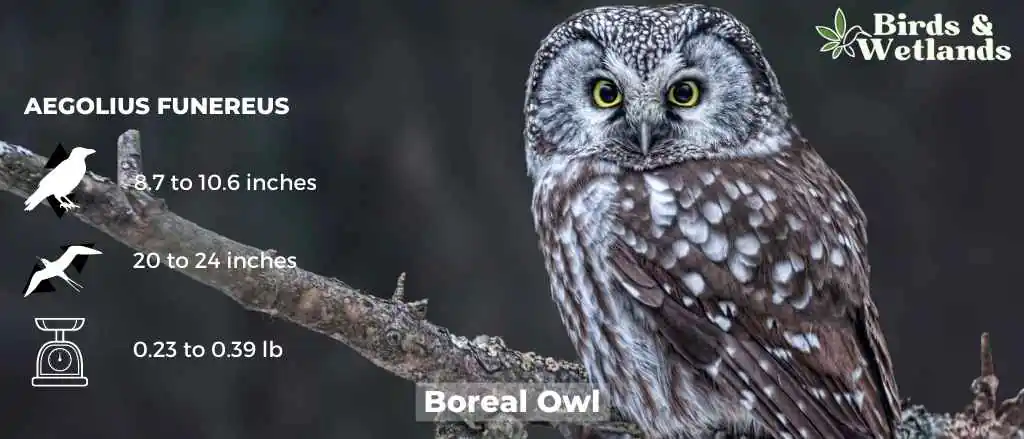
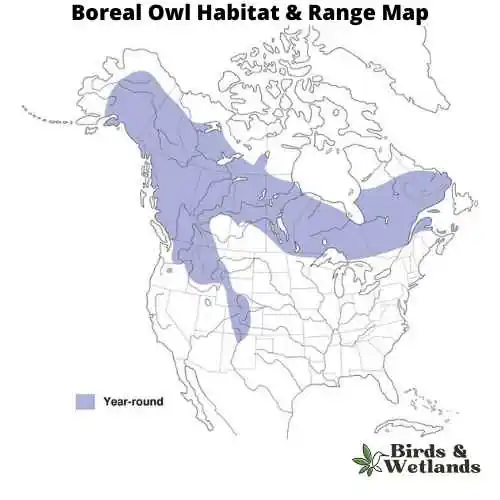
Boreal Owl Sound
Scientific Name: Aegolius funereus
Length: 8.7–10.6 in
Wingspan: 20–24 in
Weight: 3.8 oz–6.3 oz
The Boreal Owl, also known as Tengmalm’s Owl, is a small yet captivating nocturnal bird found predominantly in the northern hemisphere’s boreal forests, hence its name.
The Boreal Owl is petite in size, its plumage is predominantly grayish-brown, with white spots sprinkled on the upper parts and pale streaks on the underside, which lends a mottled effect. The bird’s rounded head, lack of ear tufts, and large yellow eyes are characteristic traits of this species.
Boreal Owls have a distinctive call, described as a series of soft, low hoots, which can often be heard during the cold winter months. As strictly nocturnal birds, they rest during the day, usually in tree cavities or similar concealed spots, and become active at night.
These owls are remarkable hunters, feeding mainly on small mammals such as voles and shrews, although they have been known to consume small birds when available. Their exceptional hearing allows them to locate prey under the snow in the darkest of nights.
Northern Hawk Owl (Surnia ulula)

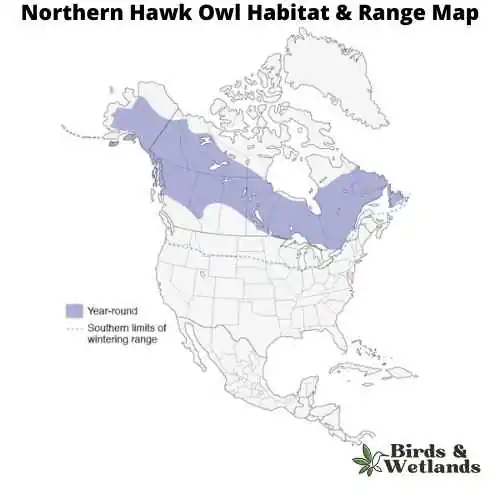
Northern Hawk Owl Sound
Scientific Name:Surnia ulula
Length: 14.2–17.6 in
Wingspan: 18 in
Weight: 11 oz-12 oz
The Northern Hawk Owl, is a medium-sized owl known for its daytime hunting habits and hawk-like behavior, hence its name.
Northern Hawk Owls are recognized by their elongated body, long tail, and lack of ear tufts – traits reminiscent of a hawk. Its plumage is generally dark brown, with white spots on the upper parts and streaks on the underparts. The owl’s face is marked by a white facial disc and distinctive black borders that make it appear somewhat masked.
Diet: consists of small mammals, such as voles, lemmings, and squirrels, but it has also been known to feed on smaller birds. The bird has an extraordinary vision that allows it to spot prey from up to 800 meters away, and it often hunts from a high perch, swooping down on its prey similar to a hawk.
Nesting typically occurs in tree cavities or abandoned nests of other birds. The female Northern Hawk Owl lays between 3 to 11 eggs and is responsible for incubation, while the male provides food and protection.
Where to Spot Maine’s Owls
Acadia National Park, Bar Harbor: Known for its biodiversity, the park is home to various owl species including Great Horned Owls, Barred Owls, and Northern Saw-whet Owls.
Baxter State Park, Millinocket: This expansive wilderness is a great spot to find Great Horned Owls, Barred Owls, and during the winter, Snowy Owls and Northern Saw-whet Owls.
Moosehorn National Wildlife Refuge, Baring: As a major migratory path, this refuge is home to several owl species, including Great Horned Owls, Barred Owls, and during migration season, Northern Saw-whet Owls.
Allagash Wilderness Waterway, Allagash: This remote wilderness provides habitats for Great Horned Owls, Barred Owls, and in colder months, Snowy Owls.
Rachel Carson National Wildlife Refuge, Wells: This refuge, with its mix of coastal and forest habitats, is a great place to spot Great Horned Owls and Barred Owls.
| State | Main Owl Watching Sites |
|---|---|
| Maine Owls | Acadia National Park, Baxter State Park |
| New Hampshire Owls | White Mountain National Forest, Great Bay National Wildlife Refuge |
Tips on How to Spot Owls in Maine?
Know the Prime Locations: Some of the best places to see owls in Maine include Acadia National Park, Baxter State Park, and the Maine Birding Trail, which features numerous wildlife areas where owls are often sighted. In winter, the snowy fields of Aroostook County can offer sightings of the majestic Snowy Owl.
Be Aware of the Time: Owls are mainly nocturnal, so the best times to spot them are at dawn and dusk. During the mating season, in late winter and early spring, you may hear their calls more frequently as they establish territories and seek mates.
Learn the Calls: Different species of owls have unique calls, and learning these can help you identify them even if you can’t see them. Recordings of owl calls can be found in various bird-watching apps and websites.
Look for Signs: Look for owl pellets at the base of large trees, which can indicate an owl’s roosting spot. Also, in the winter, you can look for their distinctive tracks in the snow.
Move Quietly and Be Patient: Owls are secretive and can be easily spooked. Move slowly and quietly, and be prepared to wait. Sometimes, the owls will come to you!
Equip Yourself Properly: A good pair of binoculars or a spotting scope can be invaluable, as owls can often be quite high in trees or hiding in dense foliage. A flashlight with a red filter can help spot owls at night without disturbing them.
Join Bird Watching Groups: Connecting with local bird watching groups or guided tours can enhance your birding experience. They often know the best spots and times for seeing specific species.

